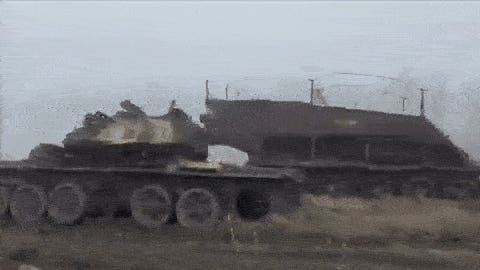The ongoing conflict between Russia and Ukraine has entered a new phase, marked by a potential shift in the balance of armored power. For the first time since the full-scale invasion began 35 months ago, Ukrainian forces may possess a localized tank advantage over their Russian counterparts. However, this superiority is not uniform across the vast 800-mile front line, but rather confined to specific sectors where Ukrainian drone operations have effectively neutralized the Russian tank threat.
The core of this evolving dynamic lies in the growing dominance of unmanned aerial systems (UAS), or drones, on the modern battlefield. Ukrainian forces have evidently achieved a significant level of proficiency in deploying and utilizing drones, deploying them in company-sized groups along the front. These drones, acting as aerial scouts and precision-guided munition platforms, have severely hampered Russian tank maneuverability. Russian bloggers, providing firsthand accounts from the front lines, have lamented the vulnerability of their tanks to Ukrainian drone strikes, forcing them to adopt static, defensive positions far behind the line of contact. This effectively relegates Russian tanks to the role of long-range artillery, negating their primary function as mobile assault weapons.
This tactical shift stands in stark contrast to the operational freedom enjoyed by Ukrainian tanks. The blogger’s account suggests that in areas where Ukrainian drone coverage is robust, Russian armored advances are effectively stifled. Ukrainian tanks, benefiting from this relative air superiority, can operate closer to the front, engaging Russian forces directly with their main guns and machine guns, maximizing their combat effectiveness. This represents a significant tactical reversal from the early stages of the war, when Russian air power and artillery dominance forced Ukrainian tanks into more cautious and restrictive roles.
The Russian blogger attributes this shift in drone dominance to several factors. Firstly, the Ukrainians have successfully scaled up their drone program, fielding a diverse array of UAS platforms tailored to various missions. Secondly, they have refined their drone tactics, integrating them seamlessly into their combined arms operations. Conversely, the Russian drone program appears to be hampered by issues of quality control, corruption, and susceptibility to Ukrainian electronic warfare. This asymmetry in drone capabilities has directly translated into a localized tank advantage for the Ukrainians.
However, the Russian military is not without countermeasures. The blogger highlights the crucial role of shoulder-fired anti-tank guided missiles (ATGMs) in mitigating the Ukrainian tank advantage. While Ukrainian tanks can maneuver more freely, they remain vulnerable to ambushes by infantry equipped with ATGMs, forcing them to maintain a degree of caution. This underscores the persistent lethality of infantry anti-tank weapons, even in an era of increasingly sophisticated drone warfare.
Further complicating the situation is the uneven distribution of advanced Russian drone technology. While conventional Russian drones are vulnerable to Ukrainian jamming, the Kremlin has deployed more advanced, fiber-optic controlled drones to priority sectors like Kursk Oblast. These drones, immune to traditional jamming methods, have proven effective against Ukrainian armor, including advanced Western-supplied tanks like the M1 Abrams and Leopard 2. This highlights the localized nature of the Ukrainian tank advantage, as it does not extend to areas where Russia has deployed its most sophisticated drone technology.
The overall picture that emerges is one of a complex and dynamic battlefield where technological advantages are not uniformly distributed. While Ukrainian forces appear to have gained a localized tank advantage due to their effective drone operations, this advantage is tempered by Russian ATGM capabilities and the deployment of advanced jam-proof drones in key sectors. The blogger’s observations also suggest a crucial limiting factor for Ukrainian offensive operations: a persistent shortage of infantry. While Ukrainian tanks can maneuver more freely and engage more effectively in some areas, the lack of sufficient infantry support may hinder their ability to exploit these advantages and capitalize on breakthroughs. This highlights the enduring importance of combined arms warfare, where tanks, infantry, and other elements work in concert to achieve decisive results. The Ukrainian tank advantage, while significant, does not automatically translate into operational dominance. It remains a potent tool, but one that must be wielded effectively within a broader combined arms framework to achieve decisive results on the battlefield.



